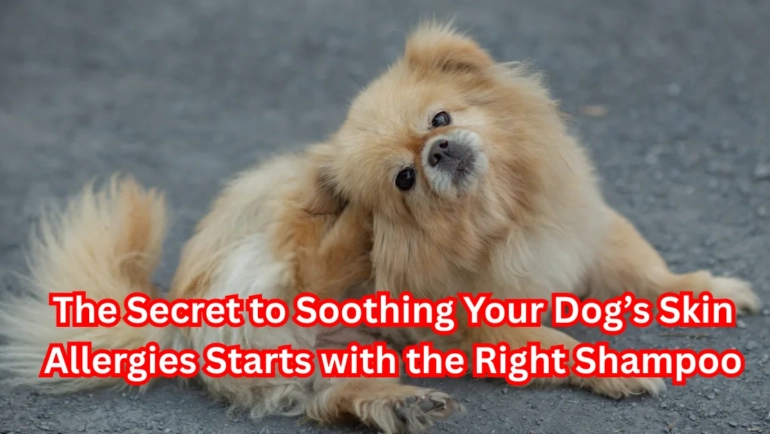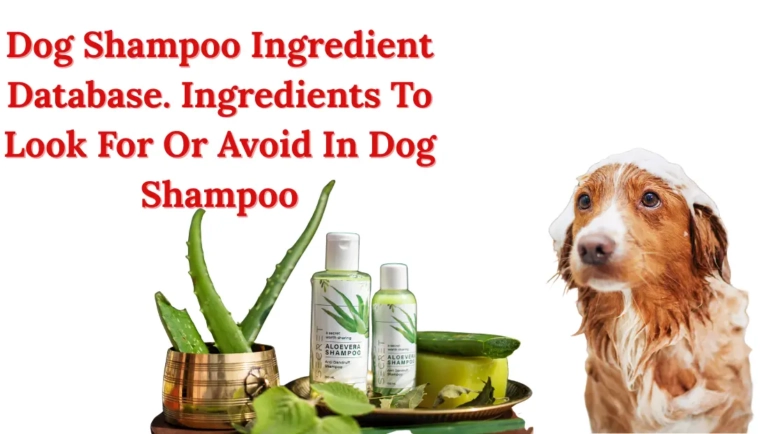
Dog Shampoo Allergies: Signs, Treatment, and Prevention
You are doing everything possible, the shampoo is so-called gentle dog shampoo, the baths are warm, you even demonstrate all the love, but your dog turns out to be scratching like mad after. I know, as I have gone through it with my dog, and trust me, it is annoying to watch my dog become happy and uncomfortable within a few hours time. The culprit? Probably a shampoo allergy that is tricky. Such reactions are not as rare as many of the pet parents might assume, and they might actually lead to a considerable level of discomfort in case they are not dealt with. But not to worry, this post will guide you on the signs you should look out, how to calm your dog down and get it so relaxed and in peace with you that it looks forward to the bath time every time again. Let us make your furry friend itch-free and fresh.
What are the indications of when a dog has an allergy to shampoo?
Another common observation that is made by a dog allergic to shampoo is symptoms such as itchiness, redness, or skin irritation soon after bath. Such reactions will leave your pup in great discomfort and as a pet parent it is not easy to observe.
The first time I took my golden mix, Rumi, to bathe, I thought that I might have not cleaned her well because I could see her scratching repeatedly. However, in the morning, her stomach was reddish and itchy and she continued licking her paws as something was clearly wrong. That is when I understood that it could be something more than a bad rinse.
What does Shampoo Allergies Look Like?
Heavy itching is probably one of the most widespread symptoms. When your dog always licks or scratches the same part of the body especially places such as the belly, legs, and neck it may be because he is reacting. It is also one of the biggest clues that the skin would appear red or inflamed in those areas. At times they can be seen on the form of small bumps, scabs or flaky skin. This indicates that your dog has a disturbance in his or her skin barrier:–maybe by the shampoo.
The response of Rumi was particularly evident at the back of her neck and at her underarms. Those were the areas where I applied the most shampoo and did not rinse out thoroughly, possibly. I saw small red ones, and she was continually rubbing herself against the couch in order to relieve herself.
The Change of Behaviours Counts Too
You should notice the behaviour of your dog when it has been bathed. They become restless, or they might be rubbing against the carpet or the furniture, or rather, they are not the same happy person as usual; these are signs that something is wrong. Rumi takes a rest after her bath, but on this day, she paced and whined quietly. It was a heartbreaker.
It is not pleasant when you see your dog in pain. When you observe these symptoms, then chances are high that the shampoo is not getting along well with their skin. Never mind that there are easy allergy-proof ways that will offer assistance. We will enter into these next.
What is the Treatment of Allergic reactions of Dogs to Shampoo?
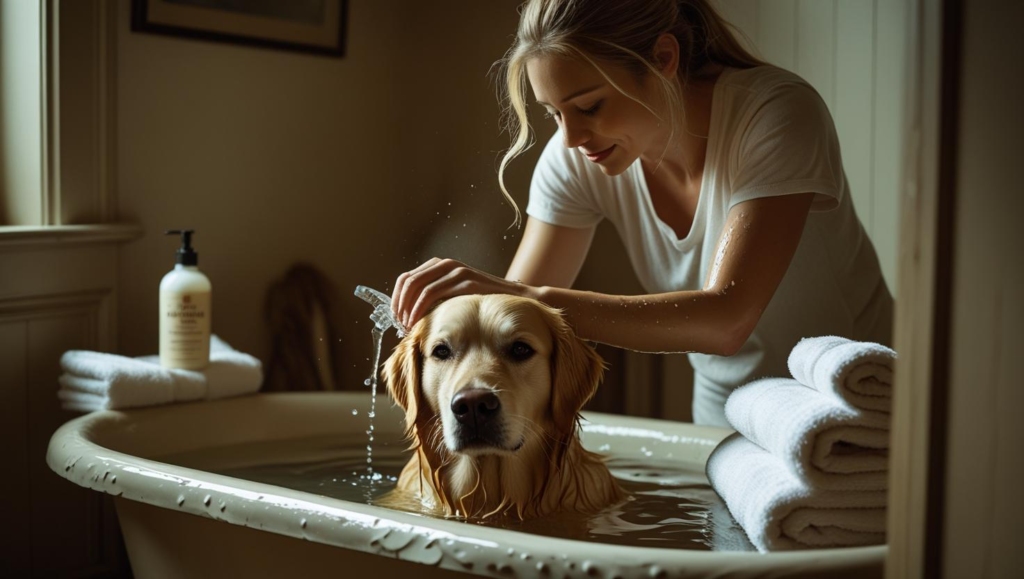
When it comes to treating an allergic reaction of a dog caused by shampoo, is fast and gentle action you needed. The majority of mild reactions can be treated at home, although when informed about the correct procedures, a world of difference can save your dog a lot of discomfort and recovery efforts.
I myself knew that the hard way after my sweet rescue girl, Rumi, had the first reaction. She would scratch her belly every now and then after a bath using a shampoo labelled as sensitive skin, and she would rub her face on the floor. Her skin appeared to be dry and slightly red as well and she appears to be quite uncomfortable. I was terrible. My first instinct was to look after Rumi, but soon after addressing the situation with our vet and performing a few online searches, I developed a routine that caused Rumi to go back to normal just within a few days. This is what succeeded.
Take off all the Shampoo the Second it gets it
You need to rinse your puppy with clean and lukewarm water first. The reaction can be prevented by rinsing any remaining shampoo, even when the bath was already earlier. Massage in the water lightly into their fur, particularly the spots behind the neck, the belly and leg areas; these places are where shampoo may be left behind.
With Rumi, I carried her right back to the tub. I rinsed longer than usual, and I only used water without any soap. I concentrated on her belly and underarms, which were areas where I had seen redness. She felt better after that, and I knew it was working.
Apply a Hypoallergenic or Oatmeal Shampoo
When the skin of your dog settles, use a sensitive skin shampoo. Seek out products containing the label warnings of being hypoallergenic or fragrance-free. Shampoos based on oatmeal are particularly useful. They relieve the skin and assist in dryness. It is preferable to avoid anything that has strong odours, artificial colours, or a long list of chemicals.
I chose a mild oatmeal and aloe shampoo, which did not have any added fragrance, for Rumi in his next bath. I was scared to do anything, yet this made wonders. No redness. No itching. A clean, happy dog.
Calm the Skin with Natural Relief
Once you wash it off, you may apply soothing topical solutions to the skin of your dog. Itching can be eased using aloe vera gel (make sure that it is pure and safe to use by a dog) or coconut oil, or a vet-approved hydrocortisone cream, which will help to reduce redness. All it requires is applying a little and observing the change.
The night following her reaction, I applied a small amount of aloe to Rumi’s tummy. It contributed to the fact that she calmed down and managed to sleep without constantly licking and scratching. I did not apply it too much, but only enough to calm irritated areas.
Observe the Symptoms and When to Call a Vet
When there is mild reaction of your dog, you should notice improvement after 24-48 hours. However, when the symptoms do not improve or get worse, it will be time to inform the vet. Such symptoms as facial swelling, relentless scratching that leads to bleeding, hives or difficulty breathing should be treated as an emergency.
Fortunately, the case of Rumi was mild. And had I noticed any sort of swelling at all, either by her eyes or face, or had she any sign of being in pain, I had not deferred. An urgent examination performed by a veterinarian can prevent several days of pain to your dog.
Avert Future Reactions
Stop using the same shampoo in case it brought about the reaction. Once you are dealing with a new product, take a small patch test each time. Apply a little bit of shampoo on one section and then rinse, and leave the body of your dog for 24 hours to check how it responds to the shampoo. This may help to avoid a whole-body response.
That is something that I continued to do since the time Rumi did. I now experiment with anything new on her side or leg. It consumes a bit more time, but it is still worth it.
Treating your dog during an allergic reaction may be stressful, but by taking constructive measures, you may make your pet recover within a short period. Nobody is as familiar with your dog as you are. When you get a bad feeling about something, it is better to listen to it. And do not forget that there are alternatives: safe, gentle shampoos. Your dog and you should have a stress-free bath day. So you will find your routine, Rumi and I did.
How soon do the allergy symptoms of a dog disappear?
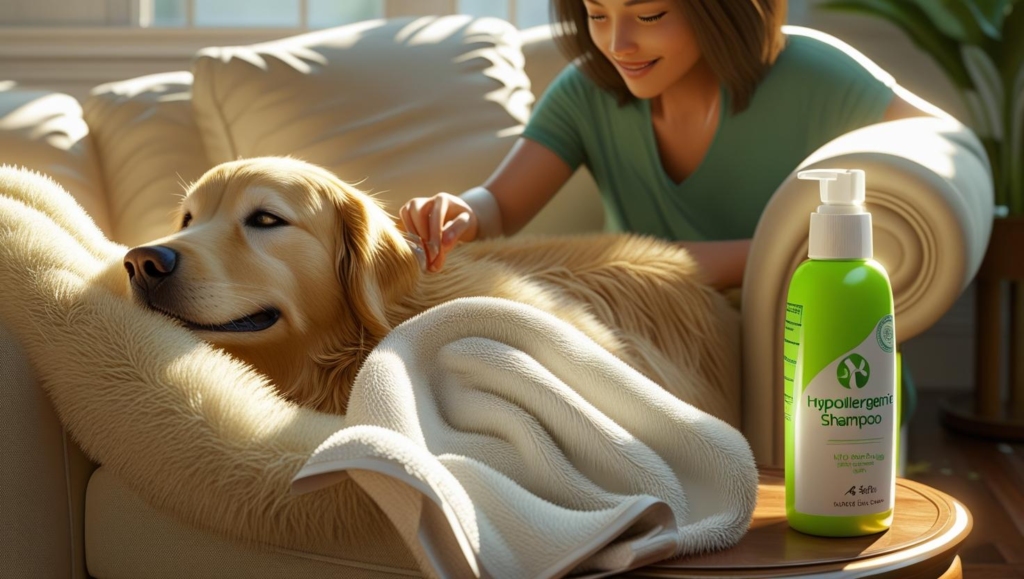
The allergies of most dog shampoos start to heal within a few days when you eliminate the trigger and remedy the occurring symptoms. How fast you react to the strength of the reaction will determine how long it will take to heal completely.
By the time Rumi had the reaction, I washed her off, changed shampoo to a gentle oatmeal one, and put aloe on the red areas. Her itching began to subside within a span of 24 hours. Three days later, her skin improved vastly, and she was back to her normal, cheery nature. However, this is not true of all dogs.
Miliary Allergies
When your dog is affected by a mild reaction, i. e. when the dog is slightly red, itchy, or has small dry areas, the symptoms generally begin improving in one to two days. When the shampoo has been washed clean and a soothing treatment is administered, the skin ought to calm down. Ensure your dog does not lick or scratch that part so hard because this slows the healing.
That was precisely the case with Rumi. Redness almost disappeared on the second day. I watched her carefully, did not give her another bath, and she got well without treatment.
Moderate and Severe Reactions
In case the reaction involves swelling, hives, relentless scratching or raw skin, it can be several days or an entire week to recover. Such reactions may require prescription medicine by the vet, such as antihistamines or corticosteroids, to limit inflammation and minimise discomfort.
Antibiotics may also be required in the event that some dogs have scratched their skin so hard that they end up getting an infection. That is why rapid action is extremely crucial.
Signs That Point to the Vet
When the symptoms of your dog do not improve within 48-72 hours or rather worsen, do not hesitate. The most appropriate thing you can do is consult your vet. The secondary skin infection may occur and the healing may take longer in case of the delay.
I have been on the double-cautious side of bath products since Rumi had this first response to it. and I have been taught that prompt treatment and tender nursing surely do shorten the road to recovery. He/she should feel better soon: and he/she will; and the what-to-do is the correct treatment and a little patience.
What Can You Do in the Case of a Dog’s Allergic Reaction to Shampoo?
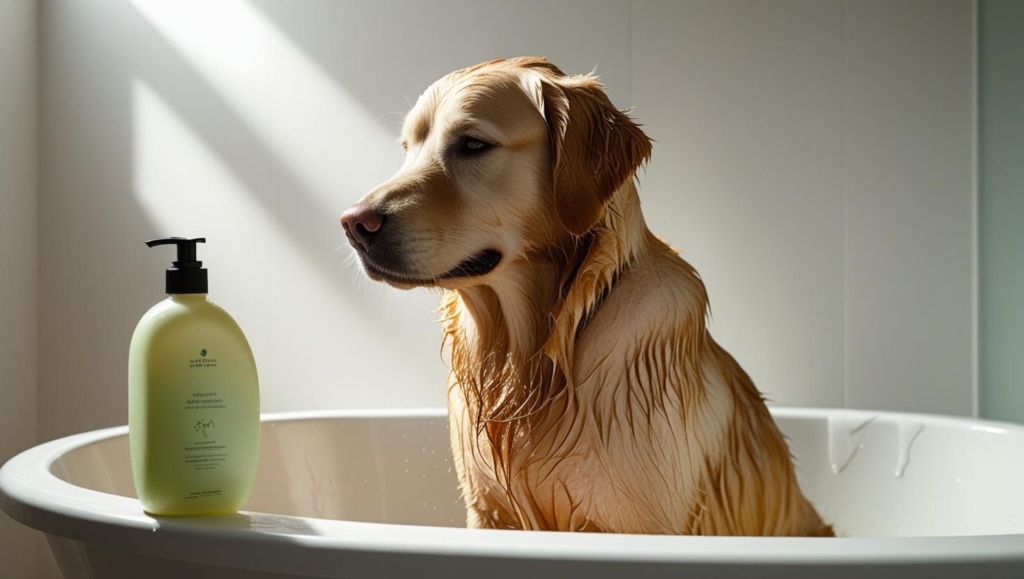
When your dog is allergic to shampoo, the best thing is to act quickly and stay level-headed. The less time you take to rinse the irritant, the more will be the chances of quick healing that the dog.
I am surprised by the first reaction Rumi received. She had just got out of the bath, and was already scratching her sides and rubbing her face on the carpet. I did not get into a panic, but I understood that I needed to take action immediately. I took her back to the tub and rinsed her out again, with tepid water and no soap, just clean water. I also took around 10 minutes to ensure that I washed off all the shampoo. It also seemed she was relaxing a little during the rinse, and that assured me that I was at the right track.
Immediately I rinsed, I laid her down gently with the help of a soft towel and held her near me so that I could observe any reactions. Within one hour, I observed some red areas on her abdomen and on the neck region. She continued to lick at her paws, and she was rather restless than ordinarily. I phoned out the vet, better to be on the safe side. Fortunately, the symptoms were minimal, and they recommended that I put a fine layer of pure aloe vera in order to calm her skin out. That was very useful.
Since the event, I have been more concerned with the manner I assisted Rumi to recover. I paid special attention so that she would not lick or chew on the inflamed areas. I even put on her a small soft cone collar, which I wore for a couple of days, to prevent aggravation. I also gave her more than just a little love: a few cuddles on the couch, some nice brushing and a few treats she adored. When they do not look or feel good, comfort makes a very important difference.
How to Avoid Dog Shampoo Allergies?
Prevention of shampoo allergies is far better than trying to deal with one when it has already developed. I now set up a couple of precautions before it is bathing time with Rumi. The first thing I did was to replace her shampoo with a hypoallergenic oatmeal-based one that did not contain any other fragrances or colouring. It is specifically designed to use on dogs that have sensitive skin, and this was a game-changer. Her coat remains untainted, and we have not had a reactionary after effect since then.
I also use a patch test before using any new product. I put on behind her ear or on inside of back leg a little bit of shampoo and wait 24 hours. In case I am not presenting any redness and itching, I find it easy to apply it to take a full bath. Minutes only, and it has saved us a great deal of headaches.
In the event that your dog has had incidences of allergic reactions in the past, then you should not put it to chance. Be sure to discuss matters with your vet. They are able to prescribe a shampoo depending on the skin type of your dog, his or her coat and past health condition of the dog. In the Rumi case, my vet prescribed a medicated shampoo, which we apply once a month, only to maintain proper skin condition and health. It is just a matter of knowing what applies to your dog and maintaining the same.
The experience with Rumi advised me that it can help to know how badly to be ready and alert. Bathing time is supposed to be a calm, bonding experience, and not one which makes your dog feel uneasy. It positively can be, with the proper products and a bit of attention.
My Final Thoughts
That was a good portion of information, but now you can trace the first symptoms of a shampoo allergy, treat it painlessly and avoid its recurrence. In case you ever felt your dog suddenly feeling itchy or uncomfortable after a bath, you now know what to look for and how to assist him. After all, it is only because after all, our dogs are not pets, but are family. We desire that bathing is something that they enjoy and would want to undertake, rather than an activity that would worsen them. I have experienced it with Rumi, and it can be quite debilitating. However, by arming yourself a bit about the process and being full of love, you can turn bath time into calm, harmless again.
Trust yourself. You are doing excellent work. And as to your dog? They already consider the world of you. Learn, be kind, and trust your instincts; your pup would be glad to have you as a human.
Commonly Asked Questions regarding Allergies to Dog Shampoo
These are some of the frequently asked questions that most pet owners tend to ask regarding dog shampoo allergies and the relevant answers that may help in taking care of your dog’s skin:
1. Is it possible to avoid Dog Shampoo allergies?
True, the allergies to dog shampoo can be avoided in a couple of instances by using hypoallergenic dog shampoos, cleaning and preventing use of harsh chemicals and carrying out a patch test prior to full application. Visiting your vet frequently will be useful in helping you get the best product that will suit the skin of your dog.
2. How to Understand that My Dog Has an Allergy to Shampoo?
Allergies to shampoo are characterised by excessive scratching, redness, swelling, bumps or dry skin patches. All these signs indicate that your dog is allergic to the shampoo used during the bath, in case it exhibits these behaviours.
3. What can I do in case my dog licks his/her skin after washing it with the shampoo?
When you shampoo your dog, be sure that he or she does not lick his or her skin, which may be prevented with the help of a collar, which is known as the Elizabethan collar. As licking proceeds, check whether there are aggravations of irritation or seek attention of your vet.
4. Can I Put Baby Shampoo on a Dog?
Baby shampoo is less harsh than other normal shampoos used on humans, but it is not designed to work on dogs, and it will still cause irritation to the dog. One should better use a special pet shampoo to exclude allergic reactions.
5. Do Shampoo Allergies lead to a permanent effect of skin harm on a dog?
The shampoo allergies do not lead to any long-term damage in the majority of cases, and when appropriate actions are taken in time. Nonetheless, once going untreated, the chronic irritation may cause skin infections, and thus, you should treat all allergic reactions as soon as possible.
6. Will Allergies Occur through Overuse of Dog Shampoo?
Using any kind of shampoo, especially that which is not intended to healthy dogs, repeatedly may dry the skin by stripping the natural oils. Which is to minimally, only when it is a must, use a type of shampoo in caring of your dog in keep the skin healthy on your dog.
7. What Be Some Home Remedies to Dog Shampoos Allergies?
There are some natural remedies, such as aloe vera, coconut oil or an oatmeal bath, which will aid in soothing the irritated skin of your dog. These can be helpful until you change the shampoo towards a better one.
8. Do Dogs Have Special Shampoos for Sensitive Skin?
Of course, there are numerous sensitive-skin shampoos that are manufactured to suit dogs. They do not normally consist of tough chemicals, fragrances, and artificial dyes and hence, are a safer bet when used by dogs that are susceptible to allergies.
9. Is it possible to apply a Dog Conditioner after bathing my Dog to prevent the Allergy?
Applying dog-specific conditioner after bathing may lock in the moisture and calm the skin, which would make it less irritable. There should be hypoallergenic, gentle conditioner used on your dog’s skin, depending on sensitivity.
10. What is the Way to Know I am Using a Dog Shampoo Safe for Allergic Dogs?
Seek those products that are hypoallergenic, free of fragrance, and gentle on sensitive skin. Also, always make sure that none of the ingredients may be a possible allergen, and in case you have some doubts as to whether a product is safe or not, always ask your vet.


